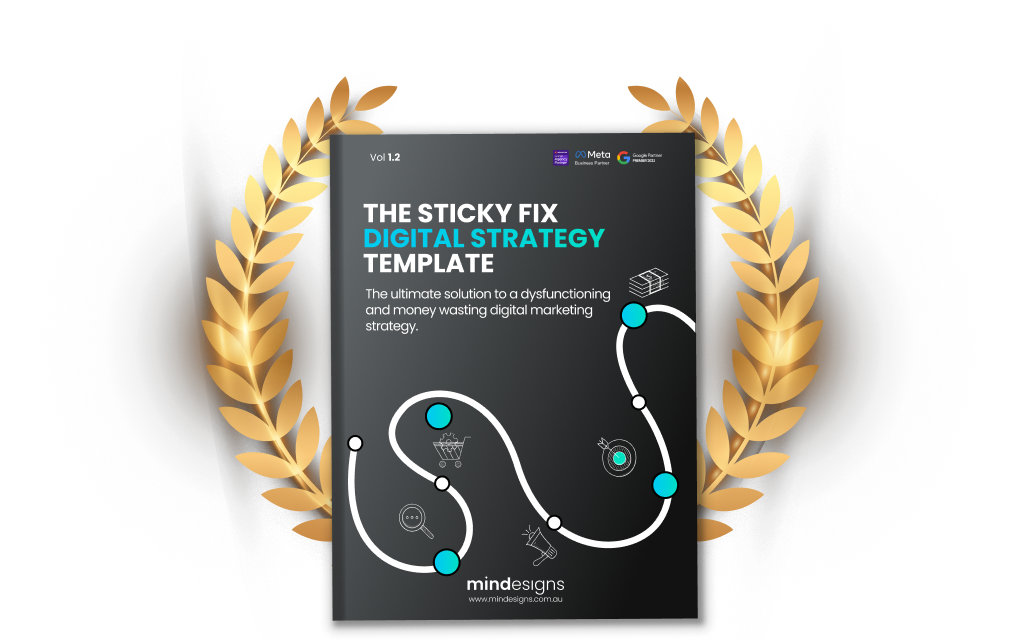Calculating the numbers behind your B2B marketing budget can be daunting and usually comes second in our list of priorities.
Still, a well-defined plan can be your roadmap towards maximising the return on ad spend (ROAS) and the overall return on your marketing efforts.
Simply guessing your marketing budget without a clear goal makes it hard to enhance your marketing strategy over time. It’s simple: If you are not recording or setting well-defined goals, how can you know what is working? If you are starting from scratch, we recommend using our Sticky Fix Digital Strategy Template.
It includes a template to help you build your:
– Buyer Persona
– Marketing Budget and COCA Analysis
– Core Marketing Funnel
– Marketing Channel Strategy
Essentially, it covers all the calculations to determine your marketing budget and maximum Cost-Per-A-Click (CPC) allowance.
Calculating Your B2B Marketing Budget
Deciding how much to allocate for your B2B marketing efforts can be a tricky task. You can either base it on a percentage of revenue or be more strategic in your process.
Goal-Oriented B2B Marketing Budget Method
The goal-oriented method prioritises a more strategic approach. Instead of simply allocating a percentage of the business revenue for marketing, it takes a more targeted approach by defining specific and measurable goals for its marketing efforts, such as generating product sales and acquiring new clients.
It then calculates the B2B marketing budget by reverse engineering your way to achieve your goals.
Our Sticky Fix Digital Strategy Template uses this method to streamline digital marketing planning. Here, we address a core issue many businesses face: the challenge of developing a coherent and robust strategy that is easy to implement and optimise.
In our approach, we start by defining how many customers or sales you want to get per month, and work backwards to determine how many visitors you need to achieve this goal.
Step 1: Define monthly customers/sales.
Step 2: Estimate your conversion rates throughout your customer acquisition journey, as demonstrated in the animation below (if you are unsure about the conversion rates, the below is a good rule of thumb).
Step 3: Work backwards and calculate how many web visitors you require to hit your monthly goal.
Our AI-assisted approach also ensures we can help you apply your marketing principles to lead a more focused and cost-effective strategy.
It takes into account your target market (buyer persona), goals, marketing budget and other expenditures (COCA Analysis), marketing content (core marketing funnel), and optimal channels (marketing channel strategy) to ensure that your budget goes to initiatives with the highest potentials for you to achieve your desired results.
Percentage of Revenue B2B Marketing Budget Method
The percentage of revenue method is the most common approach for B2B companies. It involves allocating a specific percentage of your projected annual revenue to marketing. This is typically around 7% to 15% of the total budget, although a good rule of thumb is closer to 10% or 11%.
However, the exact amount depends on factors like company size, growth stage, and competitive landscape.
While this is a good starting point, it’s not perfect. The percentage of revenue method, however, does not consider what you want to achieve. So, a startup trying to get its name out there for brand awareness will need a different budget than a company that wants to generate more leads.
For instance, a company in a crowded tech space may need to spend more money on marketing than a well-established company in a stable industry.
COCA Analysis: Understanding Your Target Audience
The Cost of Customer Acquisition Analysis calculation will help you define how much you will pay for every new customer.
Before we start with the analysis, here are some terms for you to be familiar with:
- Total Lifetime Revenue (TLR) is the total sales revenue you make from a customer over their lifetime.
- Gross Margin (GM) is the percentage of sales revenue remaining after subtracting the cost of goods sold (COGS) from the total sales revenue.
- Customer Lifetime Value (LTV) is the average revenue expected from a customer over their lifetime, after accounting for your costs.
- Cost of Customer Acquisition % (COCA%) is the percentage of the LTV you are willing to spend to acquire a new customer.
- Cost of Customer Acquisition $ (COCA$) is the amount you are willing to pay to acquire a new customer.
To calculate your COCA:
Step 1: Estimate your Total Lifetime Revenue (TLR). This is the average sales revenue over your customer’s lifetime.
Step 2: Calculate the Gross Margin (GM) by using the following equation:
GM = (Sales Revenue – Cost of Goods Sold) / Sales Revenue
Step 3: Calculate Customer Lifetime Value (LTV) by calculating the average profit expected from a customer over their lifetime (TLR x GM = LTV)
Step 4: Set the Cost of Customer Acquisition Percentage (COCA) by determining the LTV you’re prepared to spend to acquire a new customer, with 10% being a good rule of thumb.
Step 5: Calculate the COCA by multiplying LTV by the COCA percentage.
You can find a more in-depth explanation of the COCA analysis and calculation in the Mindesigns Sticky Fix Digital Strategy Template, available for download here.
Max CPC Calculation to allocate your B2B marketing budget better
If you want to squeeze the most out of your B2B marketing budget, you must consider exploring the Max Cost-Per-Click bidding strategies. These set a specific maximum amount you are willing to pay for each click on your ad.
Formula: Max CPC = Marketing Budget / Web Visitors
Marketing budget is the total amount you’re willing to spend for your ad campaign; and
Web visitors represent the number of people you ideally want to visit your website by clicking on your ads.
Using this formula, the Max CPC represents the maximum amount you’re willing to pay for each click to get the desired number of visitors.
This simplified approach to calculating your max CPC gives you a ballpark idea of how much you can potentially spend per click based on your budget and visitor goals and highlights the importance of attracting visitors.
Imagine you’re running a Facebook Ad campaign to promote your new restaurant.
Your total marketing budget is $500, and you want to attract at least 1,000 website visitors through your ads.
Using the simplified formula:
Max CPC = $500 / 1,000 visitors
Max CPC = $0.50 per visitor
This simplified approach means you could theoretically pay up to $0.50 for each click of your ad within your budget.
This gives you a starting point for calculating how much you can potentially spend and emphasises the importance of getting clicks at a reasonable cost.
That is why you must optimize your ads and target the right audience to achieve a lower CPC and stretch your budget to reach more visitors.
For a step-by-step guide, you can also explore the comprehensive Mindesigns resource on Max CPC bidding strategies here.
Measuring B2B Marketing Budget Success
Budget allocation is crucial for both methods, but measuring success goes beyond spending. Two key metrics you want to consider to understand the effectiveness of your efforts are return on Ad Spend (ROAS) and Return on Investment (ROI).
Return on Ad Spend
The Return on Ad Spend focuses on the revenue generated from marketing spend, such as advertising and social media campaigns.
Formula: ROAS = (Total Revenue Generated / Total Marketing Spend) x 100
Marketing agencies recommend calculating a minimum ROAS before launching any campaign. This allows business owners to identify whether business performance is acceptable.
Determining the minimum ROAS is somewhat complex and will depend on your business, but it can also be flexible as profit margins and business expenses adapt.
By calculating your ROAS for individual channels, you can identify which strategies deliver the best return for your investment. This allows you to optimise your B2B marketing budget and ensure that you’re investing in strategies that generate revenue.
Return on investment
Return on Investment takes on a broader view, as it looks at the profit generated from your entire marketing investment, factoring not just the revenue but all other marketing expenses, including tools and salaries.
Formula: ROI = (Gain from Investment – Cost of Investment) / Cost of Investment x 100
When ROI calculations show a positive figure, it means that the total returns exceeded the total costs, so you’re in the clear. However, if they yield a negative figure, it means that the return is in the red—or the total costs are higher than the total returns.
By using a combination of a well-defined budget, smart goal setting, and key metrics like ROAS and ROI, you can allocate your B2B marketing budget with confidence by ensuring impactful and cost-effective business growth.
Going Through B2B Marketing Budget Expenditure
Where your B2B marketing budget has to align with your overall digital strategy, here is a good rule of thumb based on our experience –
Content Marketing (20 to 40% of your marketing budget)
This informative content attracts and engages your target audience through blog posts, white papers, infographics, and webinars. It aims to establish your brand as a thought leader by nurturing leads through the sales funnel.
Advertising (20 to 30% of your marketing budget)
These are paid placements of your marketing messages across various channels, including search engine advertising on platforms like Google Ads to target users searching for specific keywords related to your products and services.
The goal is to achieve a positive ROAS, meaning you generate more revenues from ad clicks than you spend on the campaign. Social media advertising, or display advertising on relevant websites, also helps drive targeted traffic to your website and generate leads.
Search Engine Optimisation (15 to 25% of your marketing budget)
SEO helps create strategies to optimise your website content and improve its ranking in search results, ensuring your target audience finds you when searching for relevant keywords. This ensures your ideal customers find you when searching for solutions related to your products or services.
This also helps you build high-quality backlinks from reputable websites in your industry to increase your website’s authority in the eyes of search engines.
Marketing Automation (15 to 20% of your marketing budget)
This includes software that automates repetitive marketing tasks, including email marketing, lead nurturing, and social media scheduling. Some software you might want to check out include:
HubSpot Marketing Hub (starts at $22 per month) is an all-in-one platform that offers features for email marketing, lead nurturing, social media management, and analytics.
ActiveCampaign (starts at $40 per month) is a platform with automation capabilities that focuses on building strong customer relationships, including lead scoring, segmentation, and email marketing.
Pardot by Salesforce (estimated $1,800 per month) is a marketing automation solution for B2B companies that integrates with the Salesforce CRM and shows a unified view of your marketing sales efforts.
Marketing automation frees up your team’s time to focus on strategic initiatives and personalises the customer journey.
Social Media Marketing (10 to 15% of your marketing budget)
This helps build and manage your brand’s presence on social media platforms like LinkedIn, Twitter, and Facebook, connecting you with your target audience, building brand awareness, and driving traffic to your website.
This strategy could include sharing industry news articles with your insights and commentary to spark conversations and position yourself as a thought leader.
Also, running targeted ad campaigns to promote downloadable content like white papers or e-books in exchange for email signups or offering exclusive content or discounts to Facebook Group members to incentivise participation and reward loyalty.
Common B2B Marketing Budget Mistakes to Avoid
Even the most meticulous marketer can fall prey to budget blunders. Ensure you avoid these mistakes to transform your B2B marketing budget from a financial burden to a powerful tool for achieving your goals.
Blind Approach
A well-defined budget is not just a suggestion but a roadmap to your marketing success. Do not spend your money mindlessly. Instead, take the time to analyse your goals, target audience, and the industry before allocating your resources.
Groundhog Day Approach
The marketing landscape keeps evolving, and what worked last year may not be as effective today, so you should not replicate last year’s budget—that’s lazy. Instead, analyse your previous marketing performance. Identify what’s working and not, and adjust your allocation based on your current goals and industry trends.
Vanity Marketing
Some marketers focus on metrics that look good on the surface but do not translate to business goals. Remember the importance of key metrics like ROAS, ROI, and conversion rates, which provide valuable insights into the effectiveness of your campaigns. These allow you to identify areas of improvement and optimise your budget for maximum returns.
One Size Fits All Approach
Markets shift quickly, and new opportunities arise over time. Don’t lock your business with a rigid B2B marketing budget allocation. Instead, maintain flexibility to capitalise on unexpected opportunities or adjust your strategies based on market changes and performance data.
Budget Underestimation
Marketing Campaigns often have hidden costs, so be sure to factor in ongoing expenses such as maintenance fees for automation tools, design elements for content creation, or subscription costs for marketing platforms, among others.
Disconnected Sales and Marketing
Marketing and sales are two sides of the same coin, so ensure your marketing budget aligns with your sales team’s objectives. Foster collaboration and maximise lead generation efforts to drive revenue growth.
Summary
A good B2B marketing budget is your roadmap to achieving marketing goals. A data-driven approach ensures you can maximise your impact and minimise wasteful spending.
- Set clear marketing goals to guide your budget allocation
- Allocate your budget based on specific tactics needed or a percentage of revenue
- Calculate your ROAS and ROI to track campaign effectiveness and optimise spending
- Avoid budget blunders by analysing, adapting, and prioritising metrics over vanity, and maintain flexibility to adjust your strategies as necessary.
A defined budget empowers informed decision-making, allowing you to optimise your marketing efforts for the best return on investment possible.
Ready to craft your B2B marketing budget and digital strategy? Download our free template.




























































